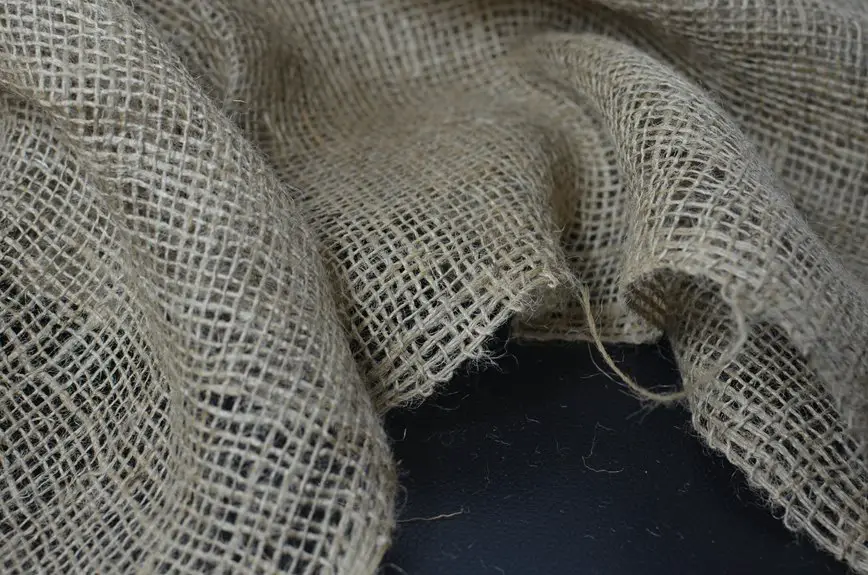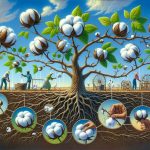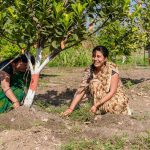When you consider eco-friendly fabrics, linen often rises to the top due to its impressive environmental benefits. It’s fully biodegradable and requires less water than cotton, making it a practical choice for sustainable living. But what truly sets linen apart? As you explore its cultivation methods and impact on biodiversity, you might find that linen isn’t just a fabric—it’s a solution to some pressing environmental challenges.
Table of Contents
Key Takeaways
- Linen is fully biodegradable, enriching soil as it breaks down naturally and reducing landfill waste.
- Flax, the source of linen, requires significantly less water than cotton, promoting water efficiency.
- Linen cultivation utilizes low-impact farming practices, enhancing soil health and biodiversity while minimizing chemical usage.
- Linen’s durability ensures long-lasting use, decreasing the need for frequent replacements and supporting sustainable living.
- Growing demand for eco-friendly fabrics positions linen as a leading choice for environmentally conscious consumers.
Biodegradability and Its Importance
When you choose linen, you’re not just opting for a stylish fabric; you’re also supporting a sustainable choice.
Linen is fully biodegradable, meaning it breaks down naturally over time without leaving harmful residues. This feature is vital in today’s world, where waste management and pollution are pressing issues.
Unlike synthetic fabrics, which can take hundreds of years to decompose, linen returns to the earth quickly, enriching the soil.
By selecting linen, you contribute to a circular economy, where materials are reused and recycled. This choice reduces landfill waste and minimizes your carbon footprint.
Choosing linen supports a circular economy, reducing landfill waste and minimizing your carbon footprint.
Every linen purchase becomes a step toward a more eco-friendly lifestyle, promoting environmental responsibility while enjoying the benefits of a durable and beautiful fabric.
Water Efficiency in Linen Production
Linen’s environmental advantages extend beyond its biodegradability, particularly in the domain of water efficiency during production. When you choose linen, you’re supporting a fabric that’s known for its low water consumption, making it a smart eco-friendly option.
Here are some key points that highlight its water efficiency:
- Drought Resistance: Flax, the source of linen, thrives in dry conditions, requiring less irrigation.
- Minimal Water Usage: It takes considerably less water to grow flax compared to cotton.
- Natural Rainfall: Linen production often relies on natural rainfall, reducing the need for artificial irrigation.
- Sustainable Practices: Many linen producers implement sustainable methods that further conserve water resources.
The Advantages of Low-Impact Farming
When you choose low-impact farming, you greatly reduce chemical usage, which benefits both your health and the environment.
This approach also enhances soil health, creating a more sustainable ecosystem.
Plus, it supports biodiversity, allowing various species to thrive alongside your crops.
Reduced Chemical Usage
Low-impact farming greatly reduces chemical usage, making it a standout choice for environmentally conscious consumers. By opting for linen, you support practices that prioritize sustainability.
Here are some key benefits of reduced chemical usage:
- Less Pesticide Dependency: Linen crops naturally resist pests, minimizing the need for harmful chemicals.
- Lower Fertilizer Usage: This method relies on organic matter and crop rotation, reducing synthetic fertilizer applications.
- Safer Water Sources: Fewer chemicals mean cleaner runoff, protecting local waterways and ecosystems.
- Healthier Communities: Reducing chemical exposure benefits farmers and surrounding communities, promoting overall well-being.
Choosing linen not only helps the planet but also supports healthier farming practices. It’s a win-win for you and the environment!
Enhanced Soil Health
By choosing linen, you contribute to enhanced soil health, which is a crucial benefit of sustainable farming practices.
Linen cultivation involves minimal chemical inputs, allowing the soil to retain its natural nutrients and structure. This low-impact farming approach promotes soil biodiversity, encouraging beneficial microorganisms that improve soil fertility.
Linen plants also have deep roots, which help prevent soil erosion and enhance water retention. This means healthier soils that can support future crops without depleting resources.
Additionally, rotating linen with other crops can lead to improved soil composition and reduced pest issues.
Biodiversity Support
The benefits of linen farming extend beyond just soil health; they also play a significant role in supporting biodiversity. By choosing linen, you’re not only opting for a sustainable fabric but also promoting practices that help preserve ecosystems.
Here are some key advantages of low-impact linen farming:
- Natural Pest Control: Linen’s cultivation encourages natural predators, reducing the need for chemical pesticides.
- Wildlife Habitat: The diverse plant life associated with flax crops provides shelter and food for various species.
- Pollinator Support: Linen farming helps sustain populations of bees and other pollinators essential for ecological balance.
- Crop Rotation: Linen fits well in crop rotation systems, enhancing soil diversity and overall farm resilience.
Durability and Longevity of Linen Fabrics
Linen fabrics stand out for their impressive durability and longevity, making them a smart choice for sustainable living. Unlike many synthetic fabrics, linen can withstand years of wear and tear, maintaining its beauty and integrity. You’ll appreciate how linen becomes softer with each wash, enhancing comfort without sacrificing strength.
Here’s a quick comparison of linen’s durability against other fabrics:
| Fabric Type | Durability Rating |
|---|---|
| Linen | High |
| Cotton | Moderate |
| Polyester | Moderate |
| Wool | High |
Carbon Sequestration and Climate Mitigation
When you think about linen, consider how flax plants actively absorb carbon dioxide from the atmosphere.
This natural carbon sequestration process not only helps mitigate climate change but also highlights linen’s role in sustainable practices.
Flax’s Carbon Absorption Capacity
Flax plants play a crucial role in carbon absorption, making them essential for climate mitigation efforts. By cultivating flax, you’re not just producing linen; you’re also helping the planet.
Here’s how flax contributes to carbon sequestration:
- Photosynthesis Efficiency: Flax absorbs significant CO2 during its growth cycle, capturing carbon efficiently.
- Soil Health: Its deep root system improves soil structure, enhancing carbon storage underground.
- Sustainable Growth: Flax requires fewer resources compared to other crops, reducing overall carbon emissions.
- Short Growth Cycle: With a rapid maturity rate, flax can sequester carbon quickly, making it a timely solution for climate challenges.
Incorporating flax into your lifestyle can be a simple yet impactful way to support the environment.
Climate Change Mitigation Effects
As you consider sustainable materials, it’s important to recognize how linen, derived from flax, can play a pivotal role in climate change mitigation.
Flax plants absorb significant amounts of carbon dioxide during their growth, effectively sequestering carbon in both the soil and plant biomass. This process reduces greenhouse gas levels, helping combat climate change.
Additionally, linen production requires fewer resources than conventional fabrics, using less water and pesticides. When you choose linen products, you’re supporting a more sustainable agricultural practice that enhances soil health and biodiversity.
Sustainable Production Practices
While many textiles strain the environment, linen stands out for its sustainable production practices.
By choosing linen, you support a process that minimizes environmental impact.
Choosing linen contributes to a more sustainable future by reducing environmental harm.
Here are four key sustainable practices that make linen a top eco-fabric:
- Low Water Usage: Linen requires considerably less water compared to cotton, making it a more sustainable option.
- Natural Pest Resistance: Flax plants resist pests naturally, reducing the need for harmful pesticides.
- Biodegradability: Linen is made from natural fibers that decompose easily, returning nutrients to the soil.
- Crop Rotation Benefits: Flax can be grown in rotation with other crops, improving soil health and reducing erosion.
Linen’s Role in Supporting Biodiversity
Linen plays an essential role in supporting biodiversity, ensuring healthier ecosystems. By choosing linen, you’re promoting the growth of flax, a plant that requires minimal pesticides and fertilizers. This cultivation method encourages natural habitats, allowing beneficial insects, birds, and other wildlife to thrive.
Flax fields often serve as refuge for various species, enhancing local biodiversity. Additionally, linen production helps prevent soil erosion, maintaining the integrity of the land and its ecosystems.
As you wear and use linen products, you’re supporting sustainable agricultural practices that protect native plants and animals.
The Economic Benefits of Linen Cultivation
When you consider the economic benefits of linen cultivation, it becomes clear that this sustainable fiber not only supports the environment but also boosts local economies.
Here are four key advantages:
- Job Creation: Linen farming and processing generate employment opportunities in rural areas, supporting local communities.
- Higher Profit Margins: Linen’s premium price often leads to better returns for farmers compared to other crops, enhancing their financial stability.
- Sustainable Practices: Cultivating linen requires fewer chemical inputs, reducing costs and promoting healthier soil, which can lead to long-term agricultural viability.
- Market Demand: The growing consumer interest in eco-friendly products means that linen cultivators can tap into a lucrative market, driving economic growth.
Comparing Linen to Other Fabrics: A Sustainability Perspective
As you explore sustainable fabric options, it’s essential to compare linen with other materials like cotton, polyester, and rayon. Linen stands out due to its low environmental impact, requiring less water and pesticides. Cotton, while natural, often demands a significant amount of water and chemicals. Polyester is synthetic, made from petroleum, and isn’t biodegradable, leading to long-lasting pollution. Rayon, though derived from wood pulp, involves harmful chemicals in its production.
Here’s a quick comparison:
| Fabric | Water Usage | Biodegradable | Chemical Use |
|---|---|---|---|
| Linen | Low | Yes | Minimal |
| Cotton | High | Yes | High |
| Polyester | Very High | No | Moderate |
| Rayon | Moderate | Yes | High |
Frequently Asked Questions
How Does Linen Affect Soil Health During Cultivation?
Imagine a garden thriving under the sun. When you grow linen, it enriches the soil, preventing erosion and enhancing biodiversity. You’re nurturing the earth, creating a sustainable cycle that benefits both plants and future generations.
Is Linen Suitable for All Skin Types and Allergies?
Linen’s hypoallergenic properties make it suitable for most skin types, including sensitive skin. However, if you have specific allergies or skin conditions, it’s wise to test a small fabric swatch before wearing linen garments.
Can Linen Be Recycled After Its Lifespan?
Yes, you can recycle linen after its lifespan. Many recycling programs accept it, allowing you to repurpose old linen into new products. Just check with your local recycling center for specific guidelines and options available.
What Are the Best Care Practices for Linen Fabrics?
Caring for linen can feel like a chore, but it’s rewarding. Wash in cold water, air dry, and avoid bleach. You’ll keep its natural beauty and durability, ensuring it lasts for years to come.
How Does Linen Production Impact Local Economies?
Linen production can boost local economies by creating jobs, supporting farmers, and engaging artisans. When you invest in linen, you’re helping strengthen communities, promote sustainable practices, and encourage local craftsmanship to thrive and flourish.
- Tetron Fabric for Marine Applications: Durability and Use Cases - June 18, 2025
- Tetron Fabric for Outdoor Furniture: Weather Resistance and Care - June 18, 2025
- Tetron Fabric for Wall Coverings: Style and Application Tips - June 18, 2025




